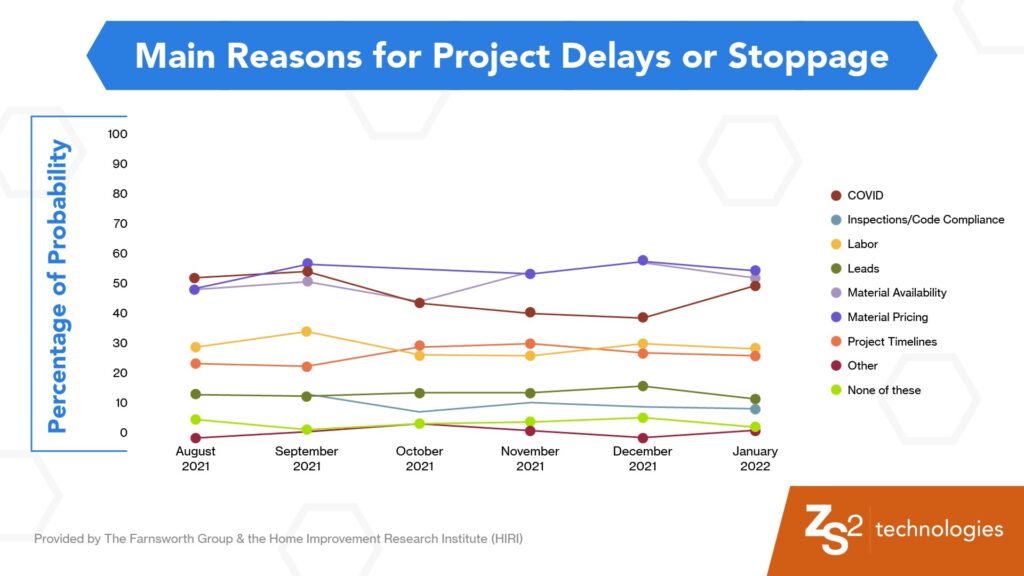Looking Ahead to 2022
- February 9, 2022
Similar to the past few years, it appears 2022 will continue to be unpredictable in almost every arena. When it comes to the construction industry specifically, that unpredictability looks a little like this:
Material prices are increasing—and increasingly volatile
- Changes in building codes are accelerating, which is driven by and enforcing energy efficiency requirements
- The labour force is being drained as people reassess their priorities
My crystal ball is showing me that we’re only going to have to pay extra special attention to these areas, because they’re only going to become increasingly important and have more of an impact on the industry—especially in the year to come.
So how can we prepare for 2022? Well, it may seem obvious, but it’s still worth stating: It’s important to get ahead of the volatility if you want to safeguard your businesses. Here’s how to do just that in each area I mentioned.
Materials
We’ve been having a lot of discussions about materials with developers, and these discussions always come down to one thing: Cost.
Costs for conventional building materials are spiking all over the world. In fact, as of January 7, the cash market price for lumber was up to $1,111 per thousand board feet; a 186% increase in—and almost triple—its bottom price in August. This price hike is due to various factors, including Millennials reaching home buying age, a rise in Canadian lumber tariffs, labour shortages, natural disasters, and a price hike for raw goods, among other things.
And it’s not just lumber…
This can make developers and builders nervous: They give their clients a quote, and two months later, they have to go back to them and say, “By the way, the price is up 25%. We’ll need to adjust for that.”
But is there a way to mitigate this type of uncertainty when it comes to materials? The simple answer is this: Don’t depend on conventional materials. How? By employing sustainable, alternative solutions like prefabrication techniques, integrated design, and products with short lead times, you can reduce or completely eliminate the need for conventional materials, meaning there’s cost certainty.
About that: The assumption we often run into is that alternative building materials are more expensive. But this couldn’t be further from the truth. In fact, when you factor in cost dependency and resiliency as well as reduced labour costs, alternative building materials are a more-than-viable option—and those are just the short-term gains.
On top of that? There’s a reduction in the delays you might experience with conventional materials. That’s right: Our lead time is one-third that of conventional materials, and our risk is mitigated because we can produce projects much faster than on-site construction. It’s a win-win.

Building Codes
When it comes to building codes, we’re seeing a lot of changes due to national building codes, provincial codes, civic codes, energy efficient initiatives, and the drive for Canada—as well as other countries like the US—to reduce greenhouse gases now being mandated.
For example, the Canadian Net-Zero Emissions Accountability Act is set to be implemented by the end of March 2022. This will bring forward an updated Emissions Reduction Plan to achieve a 40-45% reduction in emissions by 2030 from 2005 levels. Additionally, seeing as buildings are one of the greatest contributors to greenhouse gases, the British Columbia Energy Step Code now wants all new buildings to be Step Three—that’s a 20% reduction in energy usage.
Now, using conventional building materials to achieve these goals is only going to become more and more expensive. However, using alternative building materials can mean more economically-friendly construction, including the use of manufactured SIPs, an insulated panel structure, and side panels with less thermal bridging hierarchy. Now that’s a much more efficient building methodology than stick framing.
Workforce
Where did all the tradespeople go? We’ve known for a while that the landscape of the construction workforce has been changing—more like vanishing. There’s been a mass exodus and retirement due to COVID, as Baby Boomers who maybe extended their careers by a few years, as well as other workers, reassess their priorities.
This means the industry will see higher labour costs during the next 12 months than it’s seen in the past five years.
Working with alternative building solutions like prefab, there’s a predictability and security to it—especially in light of COVID. Alternative building companies use both computer and machine technologies throughout their operations, which means you can:
- Leverage technology like Revit to complete all of your ordering and preplanning upfront
- Employ remote training before your project starts to ensure everyone’s on the same page once all the materials arrive on site
When it comes to alternative building materials—like ZS2’s TechPanels—because the frame, insulation, drywall, and lines for wiring and plumbing are all built into one panel, that means you won’t have to assemble these components on site; what takes at least three hours in the field only takes an hour in the factory. It’s the swiss army knife of building materials.
Last but not least, you actually only need to hire one person that’s trained to use the materials and they’ll bring along their own team—so you don’t have to go looking for additional labour during a labour shortage.
The Final Word
Ultimately, consumer- and government-driven impositions on the construction industry are gaining momentum. That means now’s the time to jump on the solutions that are going to help you get ahead.
By understanding the value of alternative building solutions built for the earth, the builder, and the end user—like those manufactured by ZS2—you’ll be preemptively prepared and focused on the future. It’s time to build stronger, safer, and more resilient structures for all of us.

